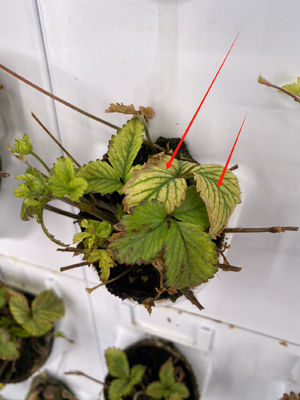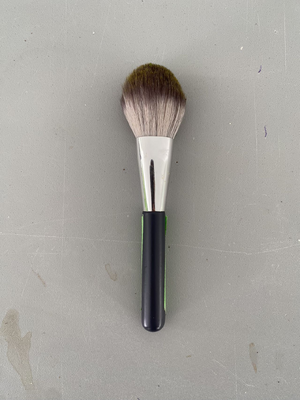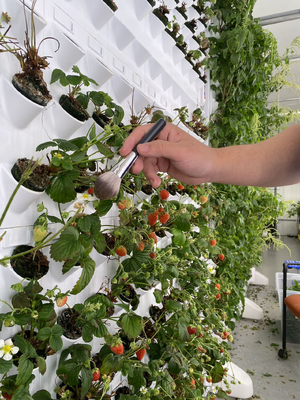Safety Training Requirements[edit | edit source]
- Dr. Pearce Safety Lab Tour
- Worker Health & Safety Awareness
- WHMIS 2015 - Workplace Hazardous Materials Information System
- Laboratory Safety & Hazardous Waste Management
Safety Issues With Method[edit | edit source]
- All the strawberry wall should be done with standard procedures to ensure all the health protocols.
- Regularly inspect strawberry walls and pots for algae accumulation and clean them with hydrogen peroxide, as they are prone to algae growth.
- When harvesting strawberries on the weekend or at any other time, ensure proper hygiene by either placing a paper towel in the agrotunnel container before harvesting and disposing of it afterward or by thoroughly cleaning the container after harvesting. Strawberries attract fruit flies due to their redness and sweetness, which can be exacerbated if containers are left uncleaned after use.
Personal protective equipment[edit | edit source]
PPE is to keep YOU safe so that you can keep doing what you want to do.
- Safety glasses – always required
- Lab Coat
- Gloves
SDS and other[edit | edit source]
- Appropriate SDS sheets should be viewed online.
- Note the hazards listed on the door to the Agrotunnel.
Equipment Name[edit | edit source]
- ICFAR- Agrotunnel
- Pollination brush
- Clippers
Varieties of Strawberries in Laboratory Research[edit | edit source]
Fresca strawberry[edit | edit source]
Fresca strawberries are a cultivar of garden strawberries known for their exceptional flavor and aromatic qualities. The Fresca cultivar is renowned for producing medium to large-sized berries with a uniform conical shape and vibrant red color. The surface of the berries is glossy and adorned with tiny yellow seeds (achenes) embedded in the skin.
Delizz strawberry[edit | edit source]
The Delizz strawberry is a cultivar known for its compact growth habit and prolific fruit production, making it ideal for both ornamental and practical cultivation in small spaces such as containers and hanging baskets. This everbearing variety is distinguished by its bright red, conically shaped berries that are noted for their sweetness and juiciness. The plant has a high yield, producing fruit throughout the growing season, typically from spring to fall. Delizz strawberries thrive in well-drained, fertile soil with a pH between 5.5 and 6.8 and require full sun exposure for optimal fruiting. They are also recognized for their resistance to common strawberry diseases, contributing to their popularity among home gardeners and commercial growers alike. Regular watering and fertilization are essential to maintain plant health and fruit quality.
Alpine strawberry[edit | edit source]
The Alpine strawberry, also known as wild strawberry or woodland strawberry, is a perennial herbaceous plant native to Europe, Asia, and North America. Unlike the common garden strawberry, the Alpine strawberry produces small, intensely flavorful berries. It thrives in well-drained, loamy soils with moderate moisture and can be found in woodland clearings and grassy areas. The plant features trifoliate leaves, white flowers, and runners that facilitate vegetative propagation. Alpine strawberries are rich in vitamins, antioxidants, and phytonutrients, making them both a nutritional and flavorful addition to various culinary dishes. The species is also of interest in genetic studies due to its simpler diploid genome compared to the octoploid genome of cultivated strawberries.
Italian strawberry[edit | edit source]
The Italian strawberry, commonly known as the wild strawberry, is a perennial herbaceous plant belonging to the Rosaceae family. This species is native to Europe, including Italy, where it thrives in woodlands, meadows, and hillsides. It is characterized by its trifoliate leaves with serrated edges, white flowers with five petals, and small, sweet, red fruits dotted with tiny seeds on the surface. The plant propagates via runners, allowing it to spread efficiently. Italian strawberries are highly valued for their intense flavor and aroma, making them a popular choice for culinary uses and natural flavoring in various food products. Additionally, they possess antioxidant properties and are a source of vitamins C and K, fiber, and essential minerals.
Valiant strawberry[edit | edit source]
The Valiant strawberry is a hybrid cultivar known for its exceptional cold-hardiness and robust growth characteristics. Developed for resilience in cooler climates, the Valiant strawberry produces medium to large-sized fruits with a bright red hue and a conical shape. The berries offer a balanced, sweet flavor profile and are notably juicy, making them ideal for fresh consumption and processing. This cultivar demonstrates vigorous plant vigor, with dense foliage that provides good ground cover, reducing weed competition. Its flowering period is mid to late season, and it is resistant to several common strawberry diseases, including powdery mildew and root rot, enhancing its reliability and productivity in diverse growing conditions.
Albion strawberry[edit | edit source]
The Albion strawberry is a day-neutral cultivar renowned for its large, firm, and conically shaped fruits. Developed at the University of California, Davis, it boasts a high yield and an extended harvest season, producing berries from late spring through fall. Albion strawberries are celebrated for their exceptional sweetness and flavor, alongside their robust resistance to common strawberry diseases like verticillium wilt and phytophthora crown rot. The plant exhibits vigorous growth and produces berries that are bright red, with a glossy finish and a firm texture, making them ideal for both fresh consumption and processing. This cultivar also demonstrates good shelf life and transportability, contributing to its popularity among commercial growers and home gardeners alike.
Strawberry Germination[edit | edit source]
Strawberry plants that have successfully germinated will typically exhibit small green shoots emerging from the soil after a minimum of one week.

Cutting the flowers of germinated strawberries, a practice known as "deblossoming", helps the plant allocate its energy towards establishing robust roots and foliage rather than producing fruit. Deblossoming should be performed within the first two to three weeks after germination. This process is particularly beneficial during the first year of planting.

To inspect the strawberry wall for germinated strawberry plants, first, identify the pots where germination has occurred. Then, check for the presence of flowers on these germinated plants. Carefully use your fingers/clippers to remove the flowers from the germinated plants.

Repeat this procedure until all flowers have been removed from the newly germinated plants.

Procedure to Avoid Chlorosis in Strawberries[edit | edit source]
Chlorosis, characterized by yellowing leaves due to insufficient chlorophyll, is a common problem in strawberry cultivation. It is often a result of iron deficiency, but can also be caused by other nutrient imbalances, waterlogging, or improper pH levels. Preventing chlorosis is essential for maintaining healthy strawberry plants and ensuring high-quality fruit production.
Chlorosis in strawberries, characterized by yellowing leaves, can be caused by several factors, including:
- Nutrient Deficiency: Lack of essential nutrients, particularly nitrogen, iron, or magnesium, can lead to chlorosis. Iron deficiency, for example, often results in interveinal chlorosis, where the area between the leaf veins turns yellow while the veins remain green.
- Poor Soil Conditions: Alkaline soil with a high pH can reduce the availability of iron and other micronutrients, leading to nutrient deficiencies.
- Water Stress: Both overwatering and underwatering can cause chlorosis. Overwatering can lead to poor root health and reduced nutrient uptake, while underwatering can cause drought stress.
- Compacted Soil: Compacted soil can hinder root growth and reduce the plant's ability to absorb water and nutrients, leading to chlorosis.
- Pest and Disease: Certain pests, such as root nematodes or spider mites, and diseases, such as root rot or fungal infections, can damage the roots or vascular system, leading to chlorosis.
- Environmental Stress: Extreme temperatures, excessive sunlight, or poor air circulation can stress the plants and lead to chlorosis.
- Herbicide Damage: Drift or misuse of herbicides can cause chlorosis and other damage to strawberry plants.
To address chlorosis in strawberries, it's essential to diagnose the specific cause and take appropriate corrective actions, such as adjusting soil pH, improving soil drainage, ensuring proper watering practices, and providing necessary nutrients.

Optimal Nutrient Absorption for Cultivated Strawberries[edit | edit source]
Some strawberries exhibit significant leaf color challenges, likely attributable to leaf chlorosis, which indicates a deficiency in nitrogen or iron. It is recommended to closely monitor the electrical conductivity (EC) to precisely determine the macro and micronutrient input. The initial step to address this issue is to add Epsom salts to the water. Epsom salts benefit plants on multiple levels and provide an inexpensive initial remedy. Bulk Barn or Walmart are suitable sources for Epsom salts, provided they do not contain added substances such as essential oils. The general recommendation is approximately 1-2 tablespoons per 1 gallon. Monitor the plants for improvements in leaf color and growth to assess if further actions are necessary. If issues persist, a nutrient formulation specific to berries may be required.
Strawberry Pollination[edit | edit source]
Pollination in strawberries is a critical process for producing high-quality fruits. It involves the transfer of pollen from the male anthers to the female stigma of the flower. This process can occur through various means, including wind, insects, or manual intervention. Successful pollination leads to fertilization, which is essential for fruit development and seed formation.
In strawberries, the efficiency of pollination significantly impacts fruit size, shape, and yield. In the Fast lab, scientists and researchers utilize a pollination brush to manually pollinate fully grown strawberry plants.

To ensure successful pollination of strawberry plants, follow these steps:
- Examine the Strawberry Wall: Inspect the strawberry wall to identify fully grown strawberries.
- Identify Flowers: Locate the flowers on the fully grown strawberries.
- Pollination Process: Gently brush the surface of the flowers twice to facilitate pollination.
- Repeat the Procedure: Continue this process until all strawberries have been pollinated.

Pollination of strawberries.
References[edit | edit source]
